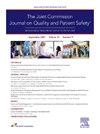Improving Awareness and Communication of Do Not Resuscitate Orders During Transitions of Care
IF 2.4
Q2 HEALTH CARE SCIENCES & SERVICES
Joint Commission journal on quality and patient safety
Pub Date : 2025-06-10
DOI:10.1016/j.jcjq.2025.06.003
引用次数: 0
Abstract
Background
Do not resuscitate (DNR) orders are not always documented at transitions of care, which may lead to inappropriate resuscitation attempts. The objectives of this study were (1) to investigate the challenges in ensuring that all staff are aware of patients’ DNR orders, (2) to examine documentation of DNR orders at transitions of care, and (3) to improve knowledge about DNR orders in institutions and at transitions of care.
Methods
This intervention initiative with pre- and post-measurements (2020 and 2023) involved hospital departments and nursing homes in Denmark. The intervention consisted of a practical instruction brochure and an end-of-life presentation. The measurements included audits of resuscitation attempts and of DNR order documentation at transitions of care. Furthermore, the participating institutions completed an electronic survey on perceived challenges.
Results
Thirty nursing homes and eight hospital departments participated in pre-measurement, 20 nursing homes and seven hospital departments participated in post-measurement, and 17 to 20 sites were included in paired analyses. The number of inappropriate resuscitation attempts was identical at pre- and post-measurements (none in nursing homes and five at the hospital). Correct documentation in nursing reports at hospital discharge increased from 32% to 53% (p = 0.003). Participating units that did not perceive challenges in ensuring knowledge of DNR orders increased from 10% to 48% (p < 0.001). At post-measurement, more than 80% of participating units had worked with models to ensure awareness of DNR orders and inclusion of DNR orders at transitions of care.
Conclusion
Participants experienced a significant increased focus on DNR orders in their own departments. Likewise, a significant increase in communication of DNR orders at transitions of care was found.
在护理过渡期间提高对“不要复苏”命令的认识和沟通。
背景:不复苏(DNR)命令并不总是记录在护理过渡,这可能导致不适当的复苏尝试。本研究的目的是:(1)调查在确保所有工作人员了解患者的无药可退医嘱方面所面临的挑战,(2)检查转诊时无药可退医嘱的文件,(3)提高机构和转诊时无药可退医嘱的知识。方法:这项干预计划包括前后测量(2020年和2023年),涉及丹麦的医院部门和养老院。干预包括实用的指导手册和临终陈述。测量包括复苏尝试的审计和护理过渡时的DNR命令文件。此外,参与机构完成了一项关于感知挑战的电子调查。结果:30家养老院和8个医院科室参与了前测,20家养老院和7个医院科室参与了后测,17 ~ 20个站点被纳入配对分析。在测量前后,不适当的复苏尝试次数是相同的(疗养院没有一例,医院有五例)。出院时护理报告的正确记录从32%增加到53% (p = 0.003)。没有意识到在确保DNR订单知识方面存在挑战的参与单位从10%增加到48% (p < 0.001)。在测量后,超过80%的参与单位与模型合作,以确保对DNR命令的认识,并在护理过渡阶段纳入DNR命令。结论:参与者在自己的部门经历了对DNR订单的显著增加的关注。同样,在护理过渡阶段,发现DNR指令的沟通显著增加。
本文章由计算机程序翻译,如有差异,请以英文原文为准。
求助全文
约1分钟内获得全文
求助全文
来源期刊

Joint Commission journal on quality and patient safety
HEALTH CARE SCIENCES & SERVICES-
CiteScore
3.80
自引率
4.30%
发文量
116
审稿时长
49 days
 求助内容:
求助内容: 应助结果提醒方式:
应助结果提醒方式:


